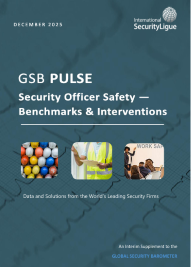
Key Points
- Despite macroeconomic challenges that are dampening merger and acquisition activity generally, M&A remains quite strong in the security industry because it has been shown to be extremely resilient.
- M&A activity in the security industry is being driven by the explosion of AI and machine learning; expansion of cloud and hybrid cloud; security’s inclusion in the hot ‘property technology’ (proptech) sector; and convergence, between physical and cybersecurity and security alarm and adjacent industries.
- Although prospects are uneven, valuations across segments in physical security have improved meaningfully and analysts are mostly bullish on the future.
- Security-as-a-service and supply chain assurance will be focal points of opportunity in the security industry in the year ahead, and despite significant numbers of strategic acquisitions in recent years, fragmentation in the security industry persists.
Mergers and acquisition trends
Overall, current merger and acquisition activity is mixed. With some quarters showing more activity year over year and others less. Some sectors are seeing growth in M&A, but some have seen significantly fewer deals, notably the life sciences industry.
The past few years have seen a slowing in major deals, the result of obstacles that include higher borrowing costs and volatility in equity markets. It is a challenging M&A market, but some analysts are hopeful. “We’re seeing some signs of light, but we are in a cautious mode,” according to Alper Cetingok, senior managing director and group head for diversified industrials, security, and safety for Raymond James.
But while the appetite for M&A broadly is weak, M&A in the security market is far from dead, according to presenters at a webinar in 2023 hosted by the Security Industry Association (US), “Financing Amid Uncertainty: Acquisitions and Capital Markets in the Security Industry.” Although focused on US financial markets, panelists discussed international players and trends, and noted the cross-border nature of financial activity impacting the industry.
“The pipeline for security industry private equity investment and strategic M&A remains quite strong just because the industry remains quite resilient,” said John Mack, executive vice president and co-head of investment banking and head of mergers and acquisitions at Imperial Capital. Mack thinks that tailwinds for the industry exceed the forces slowing it down. “For the right company, there is still a nice opportunity to attract investment capital or even M&A interest.”
Additionally, Cetingok sees decent prospects for private equity investment in the security industry due to the countercyclical and recession-resilient nature of the industry. The commercial sector continues to be the most active segment of the industry for acquisitions, with access control, commercial monitoring, fire & life safety, and video surveillance being the most active markets, he said.
What is driving M&A in security? Several forces are driving M&A and financing activity in the security industry, says Mack. Chief among them:
- Growth of AI. “In the surveillance industry, AI is a big deal and getting disproportionately more application use than in other industries, so I think we are going to continue to be in the vanguard of this technology.” This, in turn, will drive M&A activity in the industry. Primary use cases for AI and machine learning are expected in three areas: automation and threat detection solutions, including more powerful, reliable, and accurate video surveillance coupled with enhanced facial recognition and crowd monitoring; access control and enhanced site monitoring and alerting of human personnel; and automated patrolling using robots and drones.
- Expansion of Cloud and Hybrid Cloud. “Private equity guys want to invest in businesses that have these attributes,” said Mack, adding that those with older, premise-based systems are looking to invest to enter the cloud technology space. “This is going to be a driver for many years to come,” he said.
- Security as “Proptech” (the intersection of the real estate industry with technology and software). Commercial buildings, multi-family buildings, and real estate in general are pursuing the intersection of all security verticals (access control, video surveillance and analytics, security alarm, etc.) into property technology.
- Physical Security and Cybersecurity Convergence. As security technologies and devices move to the network to meet end-users’ demand for holistic threat management, security companies need to enhance their cybersecurity capabilities. Axis Communications, Honeywell, and Johnson Controls are all examples of leaders in the physical security space that have partnered with cyber companies or made other major investments in cyber.
- Convergence of Security Alarm and Adjacent Industries. Security alarm companies have increased partnerships and acquisitions in adjacent non-security markets in recent years to find new customers, cross-sell products, and create more comprehensive offerings. For example, ADT, Vivint and Brinks Home Security are among those investing in (or partnering with) companies from telecommunication, solar energy, insurance, and transportation industries.
Large security guard firms have also been among those active in acquisitions, noted the webinar panelists. Cetingok cited deals by Securitas, Allied Universal, and GardaWorld (acquiring Stanley, Attenti, and Arca, respectively), which have helped the firms to diversify and enhance their recurring revenue base.
Security industry valuations
The security industry broadly is holding up well despite challenges in the broader economy, noted presenters at the SIA webinar. Unlike many other industries, macroeconomic forces are not causing material declines in valuation levels, and, in certain cases, the industry is recording record valuations.
Over the past five to ten years, Mack said valuations in physical security have improved meaningfully across segments, with some big winners. Intelligent video, cybersecurity, and some of the ID and access control related businesses, which tend to have the highest growth rates and the highest gross margins for their services, are enjoying the highest valuations, he noted. The US guard services segment has the lowest valuations in the industry, data showed.
%2520by%2520Segment.png)
Compared to the broader US stock market, security segments—cybersecurity in particular—have outperformed. The physical security market has enjoyed 90% growth compared to 50% growth for the US market overall (see figure below). The data offers “a pretty impressive statement to investors about how our industry” stacks up against the overall equity market, according to Mack.
“Broadly, we are very bullish on both investor activity and M&A activity from strategic acquirors within the physical security industry. There are lots of sectors in this industry that are growing at double digit growth rates, and that kind of fundamental support for the industry will drive interest by investors in what are pretty attractive valuations by any historical standard,” Mack said.

Opportunity ahead
1. “Security-as-a-Service continues to be a huge long-term trend for the sector.” The remote video monitoring market especially is experiencing significant growth as it moves the video surveillance market away from one-time hardware sales and software site licenses and into a subscription-based, managed services model featuring recurring revenue. This progression of the video surveillance market is being aided by macro trends like adoption of cloud-based surveillance and increasing use of AI and machine learning that allows for greater data capture.
2. “Supply chain assurance is going to be a much bigger deal from now well into the future based on what happened during COVID.“ This trend was also cited in a global economic outlook at the Leadership Forum of the International Security Ligue in 2023 by Philip Hildebrand, vice chair of BlackRock and former the head of the Swiss central bank. In his address to Ligue membership, he noted that business is shifting from a just-in-time economy to a just-in-case economy, one in which the goal of maximum efficiency is being replaced by the need to build maximum resilience.
3. “Fragmentation in the security, fire and safety, and integration markets persists despite prolific M&A in certain areas of the market.“ It’s one reason they are still attractive to private equity investors, said Cetingok. While there may be a shift in which players own what, “fragmentation is going to remain for quite some time,” he added.






